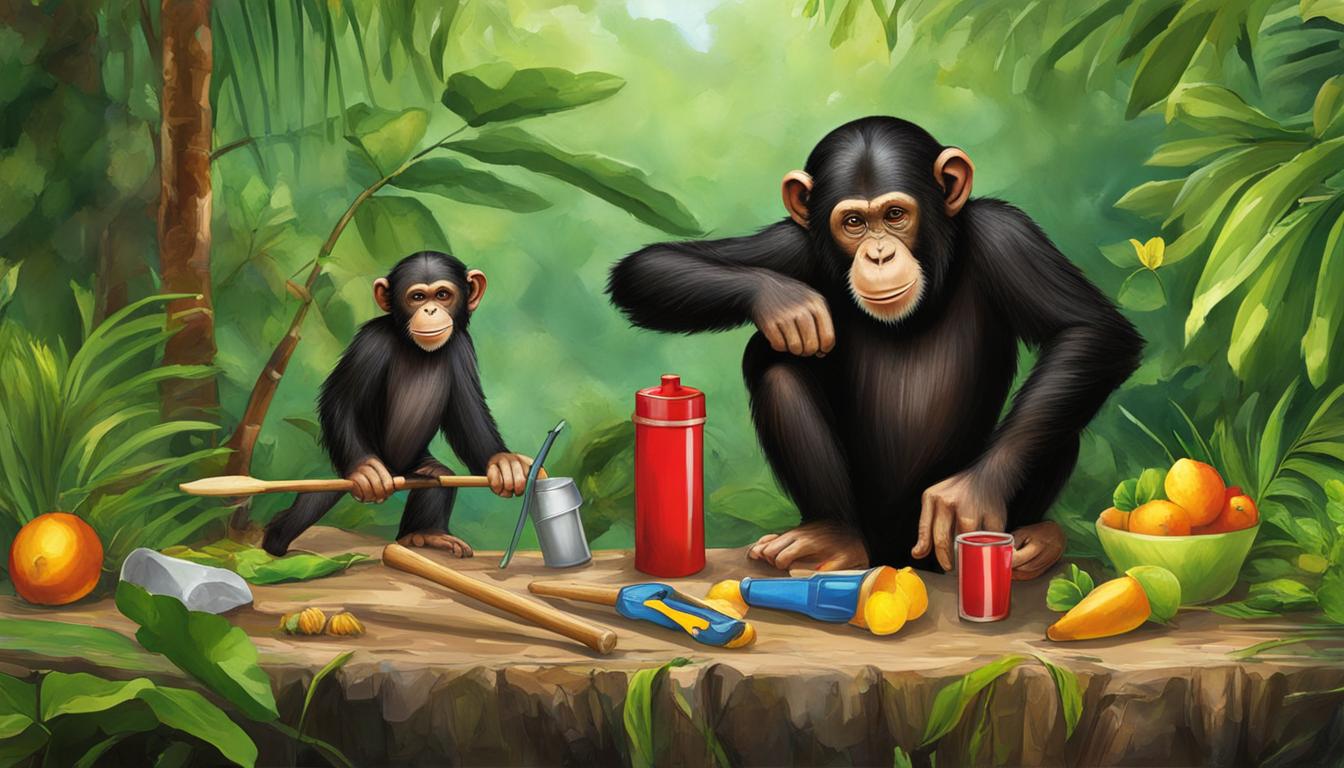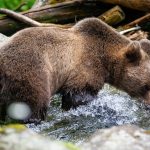Chimpanzees, our closest primate relatives, are truly fascinating creatures. As we celebrate World Chimpanzee Day on July 14, let’s uncover some intriguing facts about these incredible animals.
Chimpanzees and Humans: Close Relatives
Did you know that chimpanzees share 95 to 98 percent of their DNA with humans? This astonishing genetic similarity makes chimpanzees our closest primate relatives. We both descended from a common ancestor species that lived millions of years ago, highlighting the fascinating relatedness between our two species.
The close DNA relationship between chimpanzees and humans is not the only evidence of our connection. We also display similar physical and behavioral traits. Chimpanzees, like humans, have opposable thumbs, allowing them to grasp objects with precision. They walk on two legs, just like we do, although their primary mode of movement is climbing and swinging in trees.
In terms of behavior, chimpanzees exhibit social traits that resemble human societies. They form complex social hierarchies within their communities, with dominant alpha males leading the group. Additionally, chimpanzees display advanced cognitive abilities, problem-solving skills, and the capacity to use tools, mirroring our own intellectual capabilities.
Chimpanzees share a remarkable bond with humans, both genetically and behaviorally. Understanding our shared ancestry and relatedness can provide valuable insights into our own evolutionary journey.
Comparison of Chimpanzees and Humans
| Characteristics | Chimpanzees | Humans |
|---|---|---|
| DNA Similarity | 95 to 98% | 100% |
| Physical Traits | Opposable thumbs, bipedal movement |
Opposable thumbs, bipedal movement |
| Behavioral Traits | Social hierarchies, tool usage, problem-solving |
Social hierarchies, tool usage, problem-solving |
As we uncover more about the fascinating world of chimpanzees, our understanding of our own species and the natural world continues to deepen. The close relationship between chimpanzees and humans serves as a reminder of the interconnectedness of all living beings and reinforces the importance of conservation efforts to protect these incredible creatures.
Habitat and Distribution
Wild chimpanzees can only be found in Africa, with the largest populations inhabiting rainforest areas in about 21 African countries. These intelligent primate beings rely on their natural habitat for survival, as it provides them with the necessary resources for food, shelter, and social interactions.
Chimpanzees thrive in tropical rainforests, where they have access to abundant fruits, leaves, and insects. Their distribution is concentrated in central Africa, where the dense vegetation and access to water support their lifestyle. The map below illustrates the range of chimpanzee populations across Africa:
 |
However, the habitats of chimpanzees are under vast threat. Deforestation, driven by human activities such as logging and agriculture, has resulted in the loss of large areas of their natural habitat. This deforestation disrupts their food availability, nesting sites, and overall ecosystem balance.
In addition to deforestation, climate change poses another significant challenge for chimpanzees. Changes in temperature and rainfall patterns affect the composition and productivity of their habitats, leading to habitat fragmentation and reduced food resources.
Protecting the remaining habitats of chimpanzees is crucial for their survival and the preservation of their rich biodiversity. Conservation efforts, such as establishing protected areas, promoting sustainable land-use practices, and raising awareness about the importance of preserving their habitat, are essential for securing a future for these magnificent creatures.
Remarkable Skills and Behaviors
Chimpanzees possess remarkable skills and exhibit fascinating behaviors that highlight their incredible intelligence and adaptability. These characteristics make them one of the most intriguing species to study in the animal kingdom.
One of the most astonishing abilities of chimpanzees is their remarkable capacity for communication. These primates have been observed learning and using human languages, such as American Sign Language, to communicate with their human caretakers and researchers. This unique skill showcases their cognitive capabilities and highlights the close connection between humans and chimpanzees.
Furthermore, chimpanzees are known for their exceptional tool-use behaviors. They display a remarkable ability to employ tools in their daily lives, utilizing items like branches as instruments for extracting termites from their nests or using rocks to crack open nuts. The dexterity and problem-solving skills involved in tool use demonstrate the advanced cognitive abilities of these primates.
Chimpanzees exhibit a wide range of behaviors that parallel human social interactions. They engage in complex social hierarchies with dominant alpha males leading their extended family groups. Their social bonds, cooperation, and conflict resolution tactics demonstrate sophisticated social intelligence. Additionally, chimpanzees demonstrate problem-solving skills by employing creative tactics to overcome challenges in their environment.
Chimpanzees Communication Abilities:
Chimpanzees possess the uncanny ability to learn and use human languages like American Sign Language to communicate with humans.
Chimpanzees Tool-Use:
Chimpanzees exhibit remarkable tool-use behaviors, utilizing objects like branches and rocks to accomplish specific tasks in their day-to-day lives.
Chimpanzees Complex Social Behaviors:
Chimpanzees engage in intricate social hierarchies, cooperate and communicate within their social groups, showcasing their advanced social intelligence.
These exceptional skills and behaviors highlight the incredible cognitive abilities and adaptability of chimpanzees. Continual research into the communication, tool-use, and social behaviors of chimpanzees provides valuable insights into our own evolutionary history and expands our understanding of primate intelligence.
Diet and Feeding Habits
Chimpanzees have a diverse diet, making them omnivorous creatures. While their primary source of food is fruit, they also consume other elements such as leaves, insects, honey, and even engage in hunting small animals. This varied diet allows chimpanzees to adapt to different environments and maximize their nutritional intake.
Feeding is typically an individual activity for chimpanzees, with each member of the group searching for food independently. However, there have been instances where these intelligent creatures have been observed working together in teams to acquire food, showcasing their cooperative abilities.
Chimpanzees display fascinating feeding habits and unique behaviors when foraging. To efficiently extract termites from their mounds, they use long sticks as tools, exhibiting their problem-solving skills. Similarly, they utilize rocks to crack open nuts, demonstrating their resourcefulness in obtaining nutrition from different sources.
Their diet and feeding habits play a crucial role in their overall health and survival in the wild. By consuming a wide range of foods, chimpanzees can adapt to the changing availability and abundance of resources in their environment.
Did you know? Chimpanzees share approximately 98.7% of their DNA with humans. Their dietary preferences and behaviors offer valuable insights into our own evolutionary history and the importance of a varied diet for optimal health.
Chimpanzee Diet: A Breakdown
| Food Source | Percentage of Diet |
|---|---|
| Fruits | 60% |
| Leaves | 20% |
| Insects | 10% |
| Honey | 5% |
| Small Animals | 5% |
As shown in the table above, fruits make up the majority of a chimpanzee’s diet, accounting for approximately 60% of their food intake. This preference for fruits is attributed to their high sugar content, providing chimpanzees with energy for their active lifestyles.
Leaves form a significant portion of their diet as well, comprising approximately 20%. While leaves may not be as energy-rich as fruits, they offer important nutrients and are a readily available food source in their habitats.
Insects, including ants and termites, make up around 10% of a chimpanzee’s diet. This protein-rich food helps supplement their nutritional needs, especially during times when fruit availability is limited.
Chimpanzees also demonstrate their resourcefulness by actively seeking out honey from beehives, contributing to approximately 5% of their diet. The sticky, sweet substance not only provides them with carbohydrates but also offers various other beneficial compounds.
Lastly, hunting small animals contributes another 5% to their diet. Chimpanzees showcase their predatory instincts by catching and consuming small mammals, such as monkeys and bushbabies, further diversifying their feeding habits.
Understanding the diet and feeding habits of chimpanzees helps shed light on their ecological role and the importance of maintaining their natural habitats to ensure their survival.
Social Structure and Family Life
Chimpanzees live in fission-fusion societies, with varying group sizes and compositions over time. These social structures are dynamic, reflecting the chimpanzees’ ability to form alliances and adapt to changing circumstances. Extended family groups can range from 20 to 120 individuals, fostering complex relationships within the community.
Within these groups, a strict hierarchy is maintained, with a dominant alpha male at the top. The alpha male holds the highest social status and exerts authority over other group members. Females also have a social ranking but are subordinate to the alpha male.
Family life among chimpanzees is characterized by strong bonds between mothers and their offspring. Female chimpanzees give birth once every five years, and infant care is essential to their survival. Mothers invest significant time and effort in nurturing and protecting their young, and infants form close bonds with their mothers, relying on them for nourishment, learning, and emotional support.
During their early years, young chimpanzees rely on their mothers for guidance and protection. As they grow older, they begin to explore their surroundings and interact with other members of the community. Through social interactions, they learn the necessary skills for survival and develop their own place within the social structure.
Lifespan and Abilities
Chimpanzees have remarkable abilities and can live up to their 80s, showcasing their impressive lifespan. The oldest recorded individual reached between 76 to 82 years old. However, captive chimpanzees have a slightly lower average life expectancy of around 38 years. These intelligent animals have the ability to walk on two legs, although their primary mode of locomotion involves climbing and swinging from tree to tree.
Chimpanzees’ agility and nimbleness in their natural habitat are a testament to their physical abilities. They possess a strong upper body and are capable of performing complex movements with precision. Their ability to adapt and navigate their environment is a demonstration of their athleticism and innate intelligence.
Chimpanzees’ ability to use tools is another incredible aspect of their repertoire. They have been observed using branches to extract termites from mounds and rocks to crack open nuts. This tool use showcases their problem-solving skills and resourcefulness in acquiring food.
Furthermore, chimpanzees possess a sophisticated communication system. They use facial expressions, vocalizations, and body language to convey meaning and establish social bonds within their groups. Their social interactions, including grooming, playing, and sharing food, play a crucial role in maintaining social cohesion and ensuring the well-being of the group.
In summary, chimpanzees’ lifespan and abilities highlight their extraordinary nature. Their longevity, physical agility, tool use, and communication skills contribute to their adaptability and survival in various environments.
Endangered Status and Conservation Efforts
Chimpanzees, one of our closest primate relatives, are currently classified as an endangered species. This is primarily due to human activities such as deforestation and hunting, which have significantly impacted their natural habitats. The destruction of their habitats has resulted in a decline in their numbers and poses a threat to their survival.
However, there is hope. Numerous conservation efforts are being implemented to protect these precious animals and raise awareness about their plight. Organizations like the Jane Goodall Institute and the World Wildlife Fund (WWF) are working tirelessly to preserve chimpanzee habitats, combat illegal poaching, and promote sustainable practices.
Conservation initiatives also involve collaborating with local communities to develop alternative livelihoods that do not depend on activities harmful to chimpanzees and their habitats. Education and awareness programs are crucial in ensuring that future generations understand the importance of conservation and take action to protect endangered species like chimpanzees.
What are Some Examples of Chimpanzees Using Tools in the Wild?
In the wild, chimpanzees and tools use go hand in hand. They have been observed using sticks to “fish” for termites and ants, using rocks as hammers and anvils, and even using leaves as sponges to soak up water. These intelligent and resourceful animals continue to surprise researchers with their ingenuity.
What unique physical features of chimpanzees contribute to their interesting facts?
The unique physical features chimpanzees possess, such as opposable thumbs and complex facial expressions, contribute to their interesting facts. Their ability to use tools, strong social bonds, and 98% genetic similarity to humans also make them fascinating creatures to study in the wild or in captivity.











